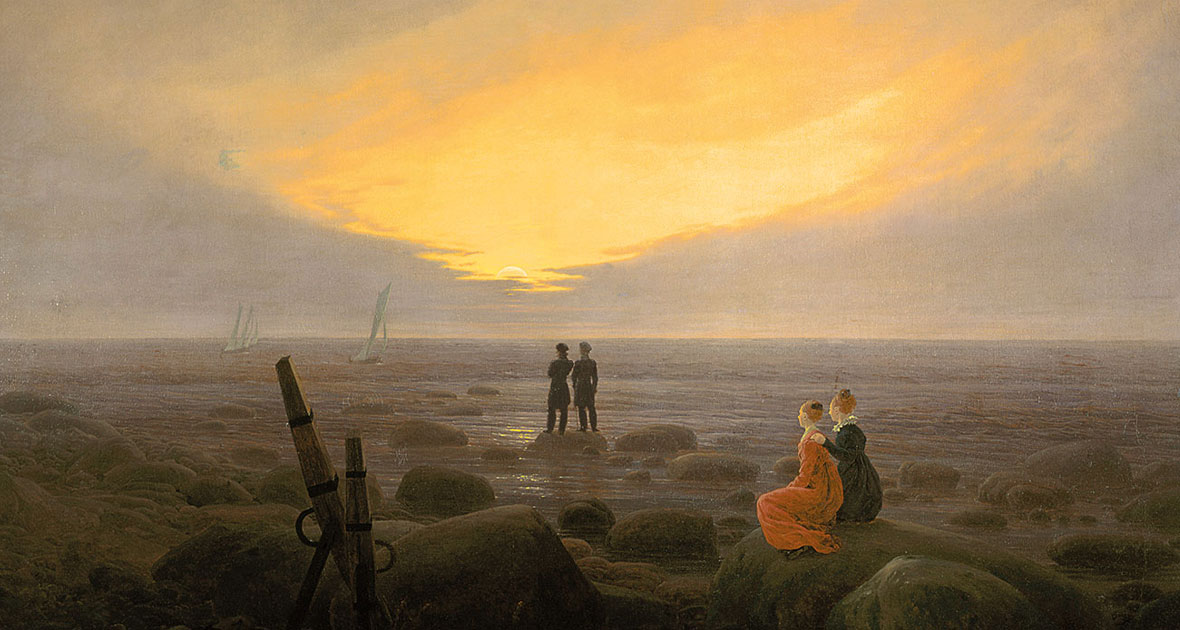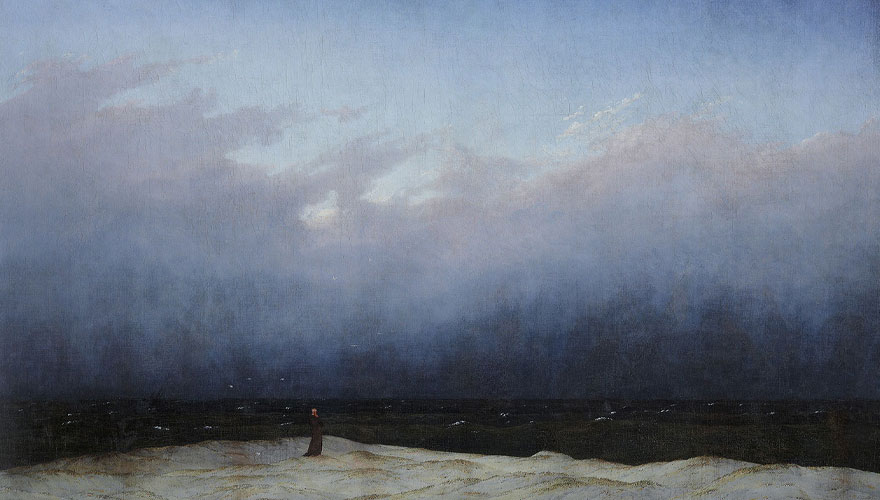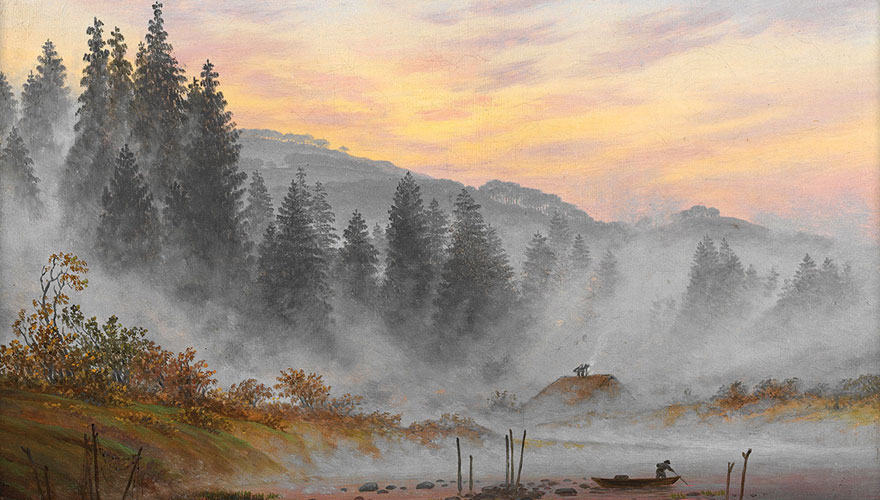
Caspar David Friedrich: A Great Romantic with Paintbrush and Canvas
"Two Men Contemplating the Moon", "The Wanderer over the Sea of Fog", or "Chalk Cliffs on Rügen": These and many other works by Caspar David Friedrich (1774 - 1840) are considered today one the great classics of art history. His works have become a trademark for Romantic painting and even for the entire Romantic movement itself. More than almost any other, he succeeded in translating the emotional world of this epoch into imagery.
He did not understand his paintings as decorative documentations of nature but rather used landscapes as symbols addressing various themes of his time: Religiosity, spirituality and mysticism, melancholy, and longing, not to mention historical events and political conditions. In doing so, he did not take on the role of a neutral chronicler. Instead, he did not shy away from giving expression to his feelings. "The only true source of art is our heart", Friedrich is supposed to have once said. His paintings were correspondingly emotional and atmospheric.
As Close to Nature as Possible
Caspar David Friedrich tried to get as close to nature as possible in his style of depiction. He was a skilled draughtsman and painted his subjects in great detail and realism. Even though his primary focus was painting landscapes, he frequently added people to his paintings - although they were often quite small in relation to nature or only appear in the background. In doing so, he conspicuously often did not depict the persons frontally but rather depicted them from behind. This meant that the characters in the picture were facing in the same direction towards nature as the viewers.

2024 Marks the 250th Anniversary of Caspar David Friedrich's Birth
Those who would like to visit a Caspar David Friedrich exhibition will have several opportunities to do so in 2023 and 2024. On the occasion of the great anniversary, various museums will be showing extensive exhibitions of the works of the Romantic painter.
Caspar David Friedrich: A Career With Ups and Downs
Caspar David Friedrich was born in Greifswald on 5 September 1774. He received his first artistic training at 16 as a student of the drawing teacher Johann Gottfried Quistorp in his native town. In 1794 he went to the Academy of Arts in Copenhagen for his studies and returned to Germany in 1798. He settled in Dresden and initially made a living as a freelance artist. Now and then, Friedrich was able to sell a work, and he additionally gave drawing lessons and coloured engravings, but he was still dependent on the financial support of his brothers.
The situation began to change for Friedrich when he won the Weimar Art Friends Prize in 1805. He subsequently achieved greater fame with his work "The Monk by the Sea", which he exhibited in 1810 and was later purchased by the Prussian king for his collection. Furthermore, in 1816 Friedrich received an extraordinary professorship at the Dresden Academy. However, as the Romantic period faded, public interest in his work eventually waned.
After a stroke, he could hardly paint and shortly after his death in 1840, he and his work were soon forgotten. His life's work was not adequately appreciated until the beginning of the 20th century. In the reception of modernism, Caspar David Friedrich now finally received his deserved status as a visionary and courageous painter and icon of Romanticism.
Friedrich Created Fantasy Scenes Instead of Documentaries in His Paintings
During his career, Caspar David Friedrich had increasingly detached his work from the traditional painting guidelines. Above all, he refused to depict reality in his paintings. Even though his landscapes appear extremely perfect and realistically elaborated, he actually only rarely showed the world as it really was in his paintings. Instead, he constructed imageries that did not even exist in this kind of topography or perspective.
However, his inspiration and motifs are certainly based on real places in Germany and Europe. There are motifs from Saxon Switzerland, the Harz Mountains and the Giant Mountains as well as from Bavaria or the Baltic Sea. He combined these set pieces in his paintings to create new fantasy worlds. After all, he was not interested in truthfully documenting the world in his paintings but rather in conveying a deep spirituality and generating emotions.

The Romantic Provoked Criticism With His Painting Method
For most of his paintings, Caspar David Friedrich made majestic nature the medium for his messages. His imposing landscape scenes symbolically expressed very personal themes such as melancholy, longing, loneliness, death, and love. But he also processed political and social content - albeit often very subtly - in his works.
Ultimately, Friedrich reduced it all to the relationship between human beings and nature. From today's perspective, there may be nothing offensive about this, but during his lifetime he gave the (art) establishment cause for criticism for several reasons. For example, Friedrich began to combine nature with religious content on the canvas. In the 18th century, this still represented a massive breach of taboo because sacred depictions still had to be strictly separated from landscape painting at that time. This was not least due to the fact that landscapes as a genre were far behind religious motifs in terms of prestige.
A prime example of Friedrich's idea of painting and the scandal he was able to cause with it is the "Cross in the Mountains" from 1808. This painting, shaped like an altarpiece, shows a landscape containing a hill with the crucified Jesus. His contemporaries partly strongly disapproved of the painting. For instance, the crucifix was painted far too small in relation to its surroundings and was only shown from behind. In this way, Frederick reduced the crucified to a staffage for the landscape.
In addition, he violated several rules of traditional pictorial composition. Among other things, central perspective and spatial depth are missing, and the lighting is also incorrect. This large number of almost revolutionary innovations in painting was too progressive for many critics of his time. Today, however, Caspar David Friedrich's work is recognised as a significant contribution to the further development of painting and even 250 years after his birth his exhibitions are real magnets for the public.
Caspar David Friedrich Exhibitions 2023 and 2024
In 2024 it will be exactly 250 years since Caspar David Friedrich was born. This is a good reason for various art galleries in German-speaking countries to organise a Caspar David Friedrich exhibition. The anniversary festivities will kick off in April 2023 with the exhibition "Caspar David Friedrich and the Harbingers of Romanticism". This is a cooperation between the "Museum Georg Schäfer" in Schweinfurt (2.4. - 2.7.2023) and the "Kunst Museum Winterthur" (26.8. - 19.11.2023).
Another exhibition starting in 2023 will be at the Kunsthalle Hamburg with the work show "Caspar David Friedrich. Art for a New Age" (15.12.2023 - 1.4.2024) with over 100 of his paintings and drawings. Finally, in the anniversary year 2024, Friedrich's birthplace Greifswald is planning an extensive programme of events with exhibitions, concerts, films, and lectures.
